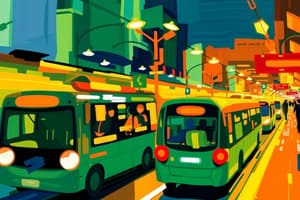Podcast
Questions and Answers
What factor most directly influences demand for travel through improved job opportunities?
What factor most directly influences demand for travel through improved job opportunities?
- Population Density
- Economic Development (correct)
- Land Use Patterns
- Transportation Infrastructure
Which of the following is NOT a component of environmental impacts analyzed in transportation projects?
Which of the following is NOT a component of environmental impacts analyzed in transportation projects?
- Air Quality
- Employment (correct)
- Noise Pollution
- Water Quality
How can policies influence travel demand in an environmentally friendly way?
How can policies influence travel demand in an environmentally friendly way?
- By promoting commercial development
- By increasing car ownership
- By expanding road networks
- By encouraging public transport use (correct)
Which of the following would likely result from an analysis of transportation impact on communities?
Which of the following would likely result from an analysis of transportation impact on communities?
What is a potential impact of technological advancements like ride-sharing services on travel?
What is a potential impact of technological advancements like ride-sharing services on travel?
What is the primary purpose of transportation demand forecasting?
What is the primary purpose of transportation demand forecasting?
Which method is characterized by using historic data to estimate future travel trends?
Which method is characterized by using historic data to estimate future travel trends?
What aspect does econometric modeling primarily consider in forecasting travel demand?
What aspect does econometric modeling primarily consider in forecasting travel demand?
Which model systematically computes trips based on the total number of journeys and their distribution?
Which model systematically computes trips based on the total number of journeys and their distribution?
The Land Use and Transportation Interaction Model examines how changes in land use patterns affect what?
The Land Use and Transportation Interaction Model examines how changes in land use patterns affect what?
Flashcards are hidden until you start studying
Study Notes
Transportation Demand Forecasting
- Forecasting predicts future travel behavior and transport service requirements.
- Essential for informing transport policies and development plans to meet expected travel needs.
- Common methods include trend extrapolation, econometric modeling, and the four-step model.
Purpose and Methods
- Trend Extrapolation: Uses historical data to predict future travel patterns; low cost but may be inaccurate if future behavior significantly differs.
- Econometric Modeling: Evaluates economic factors affecting travel demand, linking population characteristics (e.g., income) to travel behavior.
- Four-Step Model: Widely used planning technique calculating travel needs through trip generation, distribution, modal choice, and route assignment.
- Simulation Model: Recreates transportation networks for demand analysis under various scenarios to assess system performance.
- Land Use and Transportation Interaction Model: Examines how changes in land use patterns affect traffic volumes and transportation systems.
Factors Affecting Travel Demand
- Population Growth: Increased density leads to higher travel demand as more individuals require transportation within areas.
- Economic Development: Growth in the economy amplifies travel demand through enhanced employment opportunities and income levels.
- Land Use Patterns: The arrangement of commercial, industrial, and residential areas influences travel behavior and demand.
- Transportation Infrastructure: Accessibility and quality of transport services significantly impact travel demand and choice of transport modes.
- Technology: Innovations like driverless cars and ridesharing platforms could transform travel demand and characteristics.
- Environmental Policies: Policies promoting public transport or cycling can shift demand away from private vehicles, reducing carbon emissions.
Transportation Impact Assessment
- Assessing project impacts helps identify negative consequences on the environment, society, and economy, aiding stakeholder decision-making.
- Ensures maximization of project benefits while minimizing drawbacks.
Environmental Impacts
- Air Quality: Potential effects on pollution levels due to transportation projects.
- Noise Pollution: Impact of transport systems on noise levels in communities.
- Habitat Disruption: Consequences on natural environments and wildlife due to infrastructure development.
- Water Quality: Risks to water bodies from runoff or pollution associated with transport projects.
Social Impacts
- Community Disruption: Effects on local communities as a result of project implementation.
- Equity: Considerations of how transportation projects affect various demographic groups.
- Accessibility: Availability of transport options for all community members.
Economic Impacts
- Cost-Benefit Analysis: Evaluates the economic feasibility and implications of transportation projects.
- Economic Growth: Projects can stimulate local or regional economic activity.
- Property Values: Potential impact on real estate values influenced by transport accessibility.
- Employment: Job creation associated with infrastructure development and increased economic activity.
Studying That Suits You
Use AI to generate personalized quizzes and flashcards to suit your learning preferences.




